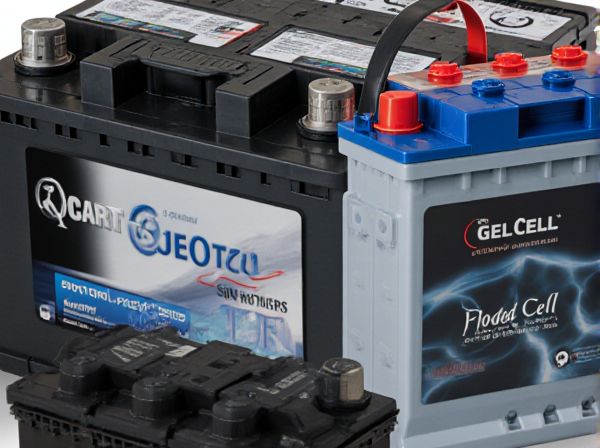
Photo illustration: Flooded Cell vs Gel Cell
Flooded cells use a liquid electrolyte that requires regular maintenance to check water levels, while gel cells contain a silica-thickened electrolyte that prevents leakage and reduces maintenance needs. Gel cells perform better in deep-cycle applications and extreme temperatures, making them ideal for solar systems and off-grid use. Understanding the differences helps you choose the best battery type for your energy storage needs.
Table of Comparison
| Feature | Flooded Cell Battery | Gel Cell Battery |
|---|---|---|
| Electrolyte | Liquid sulfuric acid (flooded) | Silica-based gel electrolyte |
| Maintenance | Requires regular water refilling | Maintenance-free |
| Durability | Good with proper care | High resistance to vibration and shock |
| Cost | Lower initial cost | Higher upfront cost |
| Performance | Reliable in most conditions | Better performance in extreme temperatures |
| Application | Common in standard vehicles | Preferred for off-road and marine vehicles |
Introduction to Battery Technologies
Flooded cell batteries use liquid electrolyte that requires regular maintenance and water topping, offering robust performance for deep cycle applications and cost-effective solutions. Gel cell batteries contain a silica-based gel electrolyte, providing spill-proof, maintenance-free operation with enhanced resistance to vibration and temperature extremes. These battery technologies cater to different needs in renewable energy, automotive, and backup power systems, balancing factors like durability, cost, and maintenance requirements.
Overview of Flooded Cell Batteries
Flooded cell batteries, also known as flooded lead-acid batteries, consist of lead plates submerged in a liquid electrolyte solution of sulfuric acid and water. These batteries require regular maintenance, including checking and refilling electrolyte levels to prevent damage and ensure longevity. Flooded cell batteries are widely used in automotive and industrial applications due to their cost-effectiveness and high tolerance for overcharging.
Overview of Gel Cell Batteries
Gel cell batteries utilize a silica-based gel electrolyte, which immobilizes the acid, enhancing resistance to vibration and leakage compared to flooded cell batteries. These sealed batteries offer maintenance-free operation, longer cycle life, and improved performance in deep discharge applications. Ideal for applications requiring durable, spill-proof energy storage, gel cells excel in marine, off-grid solar, and mobility devices.
Key Differences Between Flooded and Gel Batteries
Flooded batteries contain a liquid electrolyte that requires regular maintenance to check water levels, whereas gel batteries use a silica-based gel electrolyte that is maintenance-free and resistant to spillage. Flooded cells offer better tolerance to overcharging and higher surge currents, making them suitable for applications demanding high power, while gel cells provide superior deep discharge capabilities and are ideal for environments requiring vibration resistance and long cycle life. Temperature sensitivity also differs, with flooded batteries performing better in cold climates and gel batteries excelling in high-temperature conditions due to their sealed design.
Performance and Efficiency Comparison
Flooded cells offer reliable performance with higher tolerance for deep discharge cycles but require regular maintenance and ventilation due to electrolyte evaporation. Gel cells provide superior efficiency with minimal maintenance, improved vibration resistance, and better performance in low-temperature environments, making them ideal for applications demanding stability and longer life. Gel technology typically results in lower self-discharge rates and more consistent voltage output, enhancing overall energy efficiency compared to flooded cells.
Maintenance Requirements
Flooded cells require frequent maintenance, including regular water level checks and topping up with distilled water to prevent plate exposure and ensure longevity. Gel cells offer a maintenance-free design with sealed construction that prevents water loss, eliminating the need for watering and reducing the risk of acid spills. Proper maintenance of flooded cells contributes to optimal performance, while gel cells provide convenience through their low-maintenance nature.
Safety Considerations
Flooded cells contain liquid electrolyte, increasing the risk of spills and acid exposure, requiring proper ventilation and maintenance to prevent hazardous gases buildup. Gel cells use a silica-based gel electrolyte, minimizing acid leakage and reducing the risk of spills, making them safer for enclosed or poorly ventilated spaces. Both battery types should be handled with appropriate protective equipment to ensure safety during installation and maintenance.
Applications and Use Cases
Flooded cells are commonly used in automotive starters, forklifts, and uninterruptible power supplies (UPS) due to their cost-effectiveness and ease of maintenance. Gel cells find application in marine equipment, wheelchairs, and solar energy storage because of their spill-proof design and better performance in deep cycle usage. Both battery types serve critical roles in backup power systems, but gel cells provide enhanced durability in harsh environments and vibration-prone settings.
Cost and Lifespan Analysis
Flooded cells generally have a lower initial cost compared to gel cells, making them more budget-friendly for large-scale or stationary applications. However, gel cells offer a longer lifespan due to their sealed design and reduced maintenance requirements, which can result in lower total cost of ownership over time. Evaluating the balance between upfront investment and durability is crucial when selecting between flooded and gel cell batteries for specific use cases.
Choosing the Right Battery for Your Needs
Flooded cells offer cost-effective, high-capacity power ideal for deep-cycle applications where maintenance and water refilling are manageable, making them suited for solar energy systems and golf carts. Gel cells provide sealed, maintenance-free operation with superior vibration resistance and longer lifespan, optimal for sensitive electronics and mobility devices requiring consistent performance. Selecting the right battery depends on balancing factors such as budget, maintenance willingness, environmental conditions, and specific energy demands.
 caratoz.com
caratoz.com